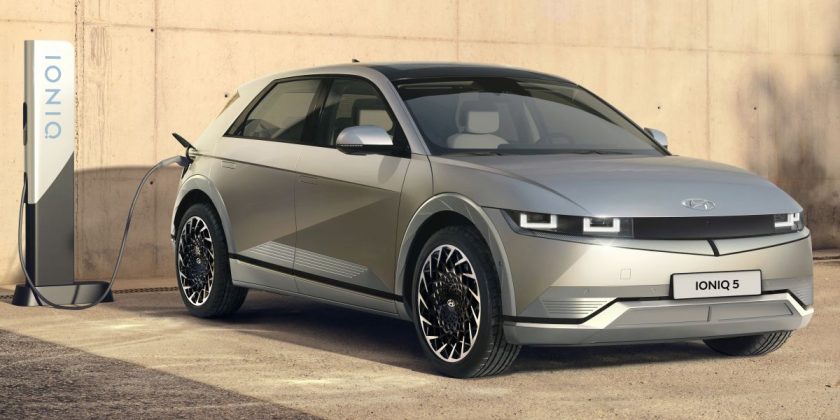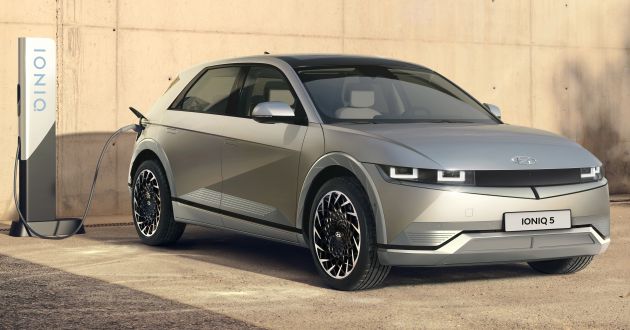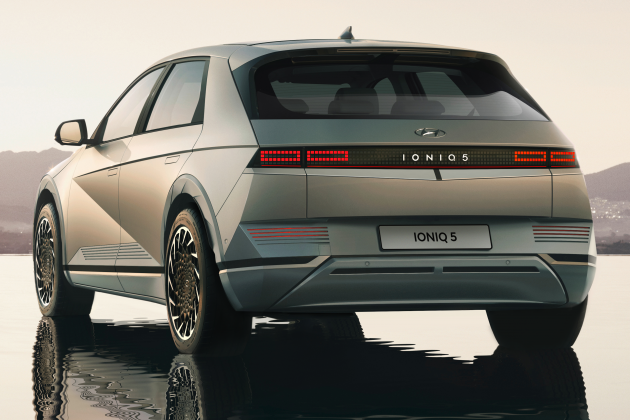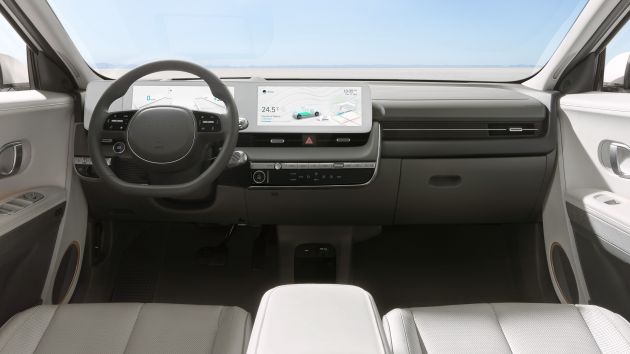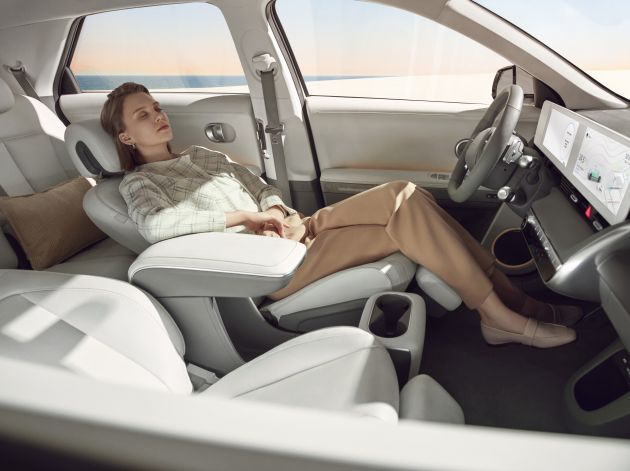No, you’re not looking at a concept car or a prop from a sci-fi movie – this is a car that, provided you’re living in the right markets, you’ll be able to buy as early as the first half of the year. This is, of course, the new Hyundai Ioniq 5, a car that precipitates a new era for the South Korean giant.
This electric crossover is the first model under the new Ioniq sub-brand and the first Hyundai to be built on the company’s dedicated Electric-Global Modular Platform (E-GMP). If the rectilinear design looks familiar, that’s because the Ioniq 5 is essentially a production version of the 45 concept from 2019 – but don’t confuse familiar with ordinary, because this car certainly isn’t.
Representing perhaps the most faithful show-car-to-showroom reproduction of all time, the Ioniq 5 retains almost the entirety of the 45’s brutalist aesthetic. This includes a side profile inspired by the company’s first car, the Pony, with bluff front and rear ends, a fast rear windscreen rake and wide C-pillars.
The front of the car is certainly distinctive, with a wide V-shaped design incorporating rectangular headlight units and pixel-like daytime running lights. It also features Hyundai’s first clamshell bonnet, reducing the number of panel gaps for both improved aerodynamics and a cleaner aesthetic – important considerations that also led to the adoption of pop-out door handles.
Moving along, the litany of creases around the front, side and rear of the car are part of Hyundai’s Parametric Dynamic design language, as seen on the latest Elantra and Tucson. The rear end continues the pixelated graphic of the headlights in its full-width taillight panel, while linear strakes around the car and an interesting “rifled” pattern on the wheel arch mouldings complete the radical design.
The Ioniq 5 may look rather compact but it’s quite a big car – measuring 4,635 mm long, it’s about as long as a long-wheelbase Tucson, while being 25 mm wider (1,890 mm) and around 50 mm lower (1,605 mm). The standout figure is the wheelbase, which at 3,000 mm is longer than even the flagship seven-seater Palisade.
One only has to gawp at the 20-inch alloy wheels on this particular unit to understand how large the Ioniq 5 is – they look just about the right size within the wheel arches. Their intricate aerodynamically-efficient design extend the Parametric Pixel design of the head- and taillights.
In total, there are five new colours to choose from, including the Gravity Gold (seen here) and Shooting-Star Grey matte finishes and the glossy Digital Teal-Green Pearl, Mystic Olive-Green Pearl and Lucid Blue Pearl. Hyundai is also promising mirror-replacing side-view cameras, which will likely be offered at a later date.
If the exterior is rather striking to look at, the interior promises to set new standards in cabin space and flexibility. The skateboard-like platform allows for the fitment of a completely flat floor which, together with the extended wheelbase, enabled designers to create a living room-esque atmosphere. A large panoramic glass roof offers up an even more airy feel.
The power-adjustable front seats feature business class-like ottomans, while the sliding Universal Sliding centre console gives even the rear occupants access to its cupholders, 15-watt wireless charger and USB ports. The front seat backs are 30% thinner to give those at the back yet more legroom.
Hyundai is claiming boot space of 531 litres, which can be increased to 1,600 litres with the sliding and reclining rear seats folded. There’s also a front trunk containing an additional 57 litres of luggage capacity. One novel feature is the vehicle-to-load (V2L) sockets under the rear seats and near the charging port, which can supply up to 3.6 kW to power things like electric bicycles, scooters and camping equipment.
As for the rest of the interior, it’s fairly pleasant looking, with a slim horizontal design, a space-saving steering column-mounted gear selector, a two-spoke steering wheel and a large freestanding display panel. The twin infotainment and instrument screens utilise a new Jong-e user interface with multiple interior ambience settings. A metal insert next to the instrument cluster can be affixed with a multi-purpose tray holder.
The Ioniq 5 is offered with the latest BlueLink connectivity, with new features that include cloud-based navigation routing, last-mile navigation, multiple user profiles and remote charging and climate control. Also available is an augmented-reality head-up display (much like the new Mercedes-Benz S-Class), natural speech recognition and an eight-speaker Bose sound system.
As this is an electric vehicle, sustainability is paramount. Many of the interior touchpoint, such as the seats, headlining, door trim, floor and armrest, are covered in eco-friendly materials. These include polyethylene (PET) recycled from plastic bottles and plant-based (bio-PET) and natural wool yarns; there are also plant-based extracts in the leather and paint. A solar roof panel can also be fitted, which prevents battery discharge and can even add to the car’s driving range.
In terms of driver assistance, the Ioniq 5 is the first Hyundai to get Highway Driving Assist 2, which keeps the car a set distance from the car in front and in the centre of its lane; it also assists in performing lane changes. Beyond that, the car’s autonomous emergency braking features cyclist, pedestrian and oncoming traffic recognition, while traffic sign recognition, high beam assist and a driver attention warning are also fitted.
Other systems include blind spot cameras on either side, blind spot collision avoidance and a door opening warning. There are also some parking aids such as a remote parking function through the smart key, a 360-degree camera, parking AEB and rear cross traffic collision avoidance.
Full specifications have yet to be released but Hyundai has announced some key headline figures. The Ioniq 5 will be available with either rear-wheel drive or two-motor all-wheel drive, plus a choice of 58 and 72.6 kWh battery capacities. Models with AWD and the largest battery option will have the most power – 225 kW (302 hp) and 605 Nm of torque, enough for them to get from zero to 100 km/h in 5.2 seconds.
You will, however, need rear-wheel drive and the 72.6 kWh battery to get the longest possible range of around 470 to 480 km on the WLTP cycle. No matter which version you get, you’ll be able to hit a top speed of 185 km/h. The Ioniq 5 also has a towing capacity of up to 1,600 kg.
In a world first, the Ioniq 5 is able to directly support both 400 V and 800 V through boosting the car’s electric motor and inverter, rather than using a separate built-in charger. With a 350 kW DC fast charger, users can charge the battery from 10 to 80% in just 18 minutes, and even just five minutes on the plug will be able to net you an extra 100 km of WLTP-rated range.
Those 350 kW chargers will be made available through the IONITY network, of which Hyundai is the latest shareholder. Customers in selected countries will receive a free one-year subscription to said network, forming part of Hyundai’s pan-European Charge myHyundai public charging service. Users can find available charging stations through the infotainment system and pay using a single credit card or app.
Source: Read Full Article
